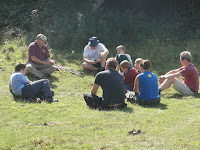I've recently just had my first play with willow bark cordage and managed to knock out a few good lengths. I sought out a few small technical details but there are lots of basic similarities with lime cordage with I've made before.
This length of lime I processed is a bit special because it was generously given to me by Will Lord who brought it to the Wild Food and Chilli Fair for me. Not only has it provided some decent lengths of bark but I've also got a good amount of bowdrill baseboards too. If you look at the picture above on the left hand side you'll see the ends are wet, The wood I got was one long length (minus a small length I chopped off to get it in my car) and I stood it in a bucket of a water for a few days to see if it helped the bark to come off and set about doing so with a Stanley knife.
Whether standing it in water helped our not I'll never know but it mostly came away with ease. Maybe it's just me but I love seeing bark come away (or a knife cut) that reveals fresh wood.
I soon had some really good quality lengths of bark in a very short time, and one naked length of lime to convert to friction fire lighting baseboards at a later date.
I could have got the length in my car at the show in one piece but elected to chop off a baseboard sized bit to get it away from my front window (I had a Bahco folding saw stashed in the boot just in case this scenraio presented itself). Interestingly I had a bit more trouble de-barking this smaller length and had to chop into it at the end. You can clearly see the lattice like pattern of the upper layer of bark.
Now at this stage, called retting, most books say something like 'Tie the lengths together and place in a stream' because the cells between the bark layers need to burst to harvest the usable strips. Well I've looked hard but I don't appear to have a watercourse of any description in my back garden so plan B is a hefty hose filled 75 litre plastic box with two or three blocks to weight the bark down.
The time this cell bursting process takes can vary but it is measured in weeks so it isn't a quick win cordage by any means. As you can see the bacterial action makes for a crust covered stagnant container and checking the bark needs a stout constitution. You'll know when it's ready by gently twisting a piece, the inner bark layers will spread out if it is, or indeed may be found separated. To retrieve the bark I used a medium sized milk container to decant as much of the water as possible and then when the container was slideable I carefully slid it to the drain and tipped the remainder down. Please note that any contact with the water and bark at most stages will cause a slight smell to linger on your skin, even after copious washing...
Taking a picture of the separated layers in the water container proved hard due to the reflection so here is what you'll see when it's ready to give them up.
This arguably the easiest stage because it takes little effort to remove the usable inner bark layers from the woody outer but do note that the pong may attract a few visitors!
The final result is a tidy amount of lime bast lengths (the word bast refers to the bark). I washed the lengths in a couple of changes of water to remove any bits of the stagnant water crust and to generally freshen them up a bit after getting a Paddington Bear stare from my wife (yes, it is that stinky). There is still a slight smell to them which reminds me a bit of ground up acorns...A much better smell than before that's for sure!
Depending on the age of the branch that gave you the lime bast you will have several layers, the exact number of layers will vary. In the pictures above You can see the lime drying over my washing line next to some willow bark cordage I'd made earlier. It drys very quickly. I've got two pieces from different parts of the process held together. The top piece has a honeycomb pattern running length ways and is from the outer part of the bark nearest the surface, the smoother length is from the inner part, nearer the centre. The latter is the stronger of the two.
The finished bark is a pleasure to roll into cordage and I think it's easier to use than the willow bark cordage (which admittedly I don't have much previous experience with) that I produced earlier in the month. It is also really flexible when it comes to storage; either hung up and graded, or folded and yet to be graded like this batch.
Now this is a hobbyist preparation of lime bast cordage and to be fair it gets a result and does negate the need for a watercourse, indeed you can find it naturally shedding when out and about.. For further reading may I suggest Bushcraft and Survival Skills issue 40 where Dave Watson talks at length in an article, and Sally Leaf did a similar detailed one in the Winter '07/ '08 issue of Bushcraft Magazine. There is also a pictorial article by Patrick McGlinchey in the short lived but rather good BushcraftUK magazine from Spring 2006 but this is somewhat tricky to find.





























































